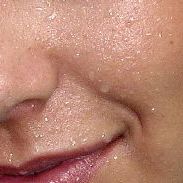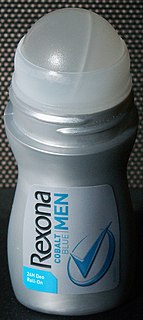This article needs additional citations for verification .(January 2021) (Learn how and when to remove this template message) |
A skin test is a medical test in which a substance is injected into the skin. [1]
This article needs additional citations for verification .(January 2021) (Learn how and when to remove this template message) |
A skin test is a medical test in which a substance is injected into the skin. [1]

Perspiration, also known as sweating, is the production of fluids secreted by the sweat glands in the skin of mammals.
The excretory system is a passive biological system that removes excess, unnecessary materials from the body fluids of an organism, so as to help maintain internal chemical homeostasis and prevent damage to the body. The dual function of excretory systems is the elimination of the waste products of metabolism and to drain the body of used up and broken down components in a liquid and gaseous state. In humans and other amniotes most of these substances leave the body as urine and to some degree exhalation, mammals also expel them through sweating.

A deodorant is a substance applied to the body to prevent or mask body odor due to bacterial breakdown of perspiration in the armpits, groin, and feet, and in some cases vaginal secretions. A subclass of deodorants, called antiperspirants, prevents sweating itself, typically by blocking sweat glands. Antiperspirants are used on a wider range of body parts, at any place where sweat would be inconvenient or unsafe, since unwanted sweating can interfere with comfort, vision, and grip. Other types of deodorant allow sweating but prevent bacterial action on sweat, since human sweat only has a noticeable smell when it is decomposed by bacteria.

Tinea cruris, also known as Jock itch, is a common type of contagious, superficial fungal infection of the groin region, which occurs predominantly but not exclusively in men and in hot-humid climates.
Body odor is present in all animals, including humans, and its intensity can be influenced by many factors. Body odor has a strong genetic basis, but can also be strongly influenced by various diseases and physiological conditions. Though body odor has played an important role in early humankind, it is generally considered to be an unpleasant odor amongst many human cultures.
Electrodermal activity (EDA) is the property of the human body that causes continuous variation in the electrical characteristics of the skin. Historically, EDA has also been known as skin conductance, galvanic skin response (GSR), electrodermal response (EDR), psychogalvanic reflex (PGR), skin conductance response (SCR), sympathetic skin response (SSR) and skin conductance level (SCL). The long history of research into the active and passive electrical properties of the skin by a variety of disciplines has resulted in an excess of names, now standardized to electrodermal activity (EDA).

Miliaria, also called "sweat rash", is a skin disease marked by small and itchy rashes due to sweat trapped under the skin by clogged sweat gland ducts. Miliaria is a common ailment in hot and humid conditions, such as in the tropics and during the summer season. Although it affects people of all ages, it is especially common in children and infants due to their underdeveloped sweat glands.

Sweat glands, also known as sudoriferous or sudoriparous glands, from Latin sudor 'sweat', are small tubular structures of the skin that produce sweat. Sweat glands are a type of exocrine gland, which are glands that produce and secrete substances onto an epithelial surface by way of a duct. There are two main types of sweat glands that differ in their structure, function, secretory product, mechanism of excretion, anatomic distribution, and distribution across species:

The labia are part of the female genitalia; they are the major externally visible portions of the vulva. In humans, there are two pairs of labia: the labia majora are larger and fattier, while the labia minora are folds of skin between the outer labia. The labia surround and protect the clitoris and the openings of the vagina and the urethra.

Harlequin syndrome is a condition characterized by asymmetric sweating and flushing on the upper thoracic region of the chest, neck and face. Harlequin syndrome is considered an injury to the autonomic nervous system (ANS). The ANS controls some of the body's natural processes such as sweating, skin flushing and pupil response to stimuli. Such individuals with this syndrome have an absence of sweat skin flushing unilaterally; usually on the one side of the face, arms and chest. It is an autonomic disorder that may occur at any age. Harlequin syndrome affects fewer than 200,000 people in the United States.
The sweat test measures the concentration of chloride that is excreted in sweat. It is used to screen for cystic fibrosis (CF). Due to defective chloride channels (CFTR), the concentration of chloride in sweat is elevated in individuals with CF.

Hypohidrotic ectodermal dysplasia is one of about 150 types of ectodermal dysplasia in humans. Before birth, these disorders result in the abnormal development of structures including the skin, hair, nails, teeth, and sweat glands.

Eccrine sweat glands are the major sweat glands of the human body, found in virtually all skin, with the highest density in palm and soles, then on the head, but much less on the torso and the extremities. In other mammals, they are relatively sparse, being found mainly on hairless areas such as foot pads. They reach their peak of development in humans, where they may number 200–400/cm² of skin surface. They produce a clear, odorless substance, sweat, consisting primarily of water. These are present from birth. Their secretory part is present deep inside the dermis.

Cholinergic urticaria (CU) is a type of physical urticaria that appears when a person is sweating or their core body temperature increases.
Hypohidrosis is a disorder in which a person exhibits diminished sweating in response to appropriate stimuli. In contrast with hyperhidrosis, which is a socially troubling yet often benign condition, the consequences of untreated hypohidrosis include hyperthermia, heat stroke and death. An extreme case of hypohydrosis in which there is a complete absence of sweating and the skin is dry is termed anhidrosis.
Sudomotor describes anything that stimulates the sweat glands.
Skin appendages are skin-associated structures that serve a particular function including sensation, contractility, lubrication and heat loss. In humans, some of the more common skin appendages are hairs, arrector pilli, sebaceous glands, sweat glands, and nails (protection).

Eccrine carcinoma is a rare skin condition characterized by a plaque or nodule on the scalp, trunk, or extremities. It originates from the eccrine sweat glands of the skin, accounting for less than 0.01% of diagnosed cutaneous malignancies. Eccrine carcinoma tumors are locally aggressive with a high rate of recurrence. Lack of reliable immunohistochemical markers and similarity to other common tumors has made identification of eccrine carcinoma difficult.
The Minor test, described by Victor Minor in 1928, is a qualitative medical test that is used to evaluate sudomotor function.
As in other mammals, thermoregulation in humans is an important aspect of homeostasis. In thermoregulation, body heat is generated mostly in the deep organs, especially the liver, brain, and heart, and in contraction of skeletal muscles. Humans have been able to adapt to a great diversity of climates, including hot humid and hot arid. High temperatures pose serious stress for the human body, placing it in great danger of injury or even death. For humans, adaptation to varying climatic conditions includes both physiological mechanisms resulting from evolution and behavioural mechanisms resulting from conscious cultural adaptations.